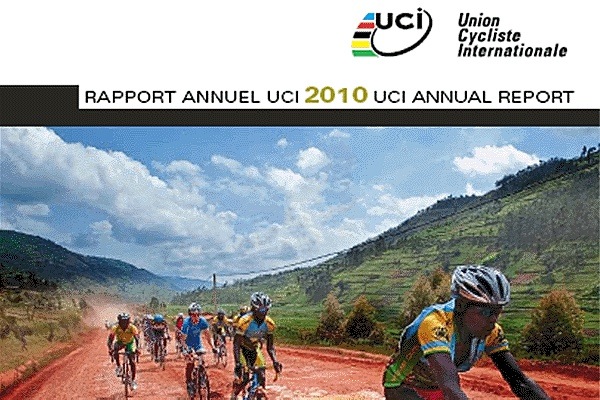Having considered the Amaury family, it’s now time to introduce another of this sport’s stakeholders, the UCI and the effect they have on the revenue sharing debate. We begin by looking at the UCI’s recently-released accounts for 2010.
The UCI, being cycling’s governing body, have a role to play in the revenue-sharing debate. It is not simply a question of revenue sharing between the race organisers and the teams. The next few parts of this series will consider the role the UCI currently plays.
Let’s begin by looking at the financial health and well-being of the UCI. With the 2010 accounts having recently been slipped into the public domain, let’s start there. Below is the summarised version of the UCI income and expenditure statement, with comparative figures for the two preceding financial years.
A note on currencies: The UCI is Swiss-based. Their accounts are denominated in Swiss francs (CHF). An obscure currency. Unless you happen to live inSwitzerland. Or make use of its banking services. For the most part, I’m not going to convert the figures into meaningful values. The reason will be made clear in due course. Most of you are probably already well aware of it, Bloomberg having been prompted to highlight the problem some months back.
|
2010 |
|
2009 |
2008 |
||
| Revenue |
25,553,082 |
26,817,269 |
30,684,209 |
||
| Direct Costs |
(13,246,642) |
(14,970,083) |
(18,292,400) |
||
| Gross Surplus |
|
12,306,440 |
|
11,847,186 |
12,391,809 |
| Indirect Costs |
(10,078,196) |
(13,353,980) |
(13,907,087) |
||
| Gross Operating Surplus / (Deficit) |
|
2,228,244 |
|
(1,506,794) |
(1,515,278) |
| Net Financial Income / (Expenditure) |
(1,062,479) |
1,044,111 |
(1,637,618) |
||
| Depreciation |
(888,009) |
(1,039,217) |
(1,044,294) |
||
| Exceptional Income / (Expenditure) |
(77,565) |
289,669 |
240,669 |
||
| Carry-over from Previous Years |
(85,969) |
(12,429) |
(23,416) |
||
|
(2,114,022) |
282,134 |
(2,464,659) |
|||
| Surplus / (Deficit) before reserve adjustment |
|
114,222 |
|
(1,224,660) |
(3,979,937) |
| Transfer from General Reserve |
0 |
1,280,000 |
4,035,001 |
||
| Net Surplus |
|
114,222 |
|
55,340 |
55,064 |
The revenue line we’ll come back to later. All I’ll say is that it’s not all it seems to be. Let’s skip over the direct costs too, for the moment. There are stories to be told among them, but another day. Of the indirect costs, the figure of immediate interest is the UCI’s wage cost.
Over the last few years, the UCI has begun to get its act together, financially speaking. It took a long, hard look at itself in the mirror. The reflection was not pretty. The UCI was fat and flabby. So a little bit of body sculpting has been going on recently. A lot of the change has been shuffling the deck, moving things around and putting a different shape on the organisation. Some serious savings, though, have been pay in the area of payroll:
|
2010 |
2009 |
2008 |
|
| Payroll |
6,311,723 |
8,935,308 |
8,776,732 |
| Travel & Entertainment |
133,461 |
110,926 |
212,712 |
|
6,445,184 |
9,045,604 |
8,989,444 |
Knocking 2.6 million Swiss francs off the payroll costs is no mean feat. How, you must wonder, was it done? Let’s look at a headcount:
|
2010 |
2009 |
2008 |
|
| UCI Staff |
63 |
63 |
75 |
| CMC Exploitation Staff |
17 |
17 |
17 |
| CMC Training Staff |
10 |
10 |
7 |
|
27 |
27 |
24 |
|
| CADF Staff |
10 |
7 |
0 |
| Commissaires |
541 |
562 |
610 |
| Technical Delegates |
17 |
19 |
19 |
| Doping Control Agents |
69 |
44 |
78 |
|
627 |
625 |
707 |
|
| Management committee |
17 |
17 |
17 |
While the bonfire of the blazers looks interesting (the number of commissaires falling from 610 in 2008 to 541 in 2010) don’t let that distract you. The first question you really have to ask is what (who) is actually included in the salaries figure quoted earlier. The CMC staff are not. Nor are the CADF staff. (Despite hiving both of these activities off to special-purpose vehicles, for some reason their staff numbers are disclosed in the accounts, as if the UCI felt they had some moral obligation toward them.) Are the commissaires, etc. salaried? Highly unlikely. And not if the HR section of the UCI’s annual report is to be credited. Are the management committee salaried or just on expenses? Good question.
If, as seems most likely, the number of people included in the salaries figure is just the UCI staff of 63, this suggests an average salary of just over 100,000 Swiss francs per head. That’s an average: some people get paid less than the average, that’s the way averages work. And some people get paid more. How many get paid more would tell you how much more they get paid. Sadly, the UCI’s accounts lack opacity on this issue.
But the real question here is how the saving in salaries was achieved when you look at what happened to the head count. Twelve staff were lost between 2008 and 2009 but none between 2009 and 2010, and yet still there’s a saving of 2.6 million Swiss francs in 2010. Some of that could be attributable to the 2009 change in head count, as there appears to have been (as the UCI accounts euphemistically refer to it) a non-recurring charge of 977,375 Swiss francs relating to reorganisation in 2009. Call that redundancy (which is what it’s usually the euphemism for) and not only is the 977,375 CHF non-recurring, so too is the salary base to which it was attached. Which for that sort of payoff must have been pretty impressive. That, then, could explain a large chunk of the 2.6 million Swiss francs saved. But not all.
But here’s where things get strange. In 2009, the UCI had a total of 13 resignations/redundancies. They appointed an additional 11 staff. That’s a net reduction of just 2 staff members. Go back to the head-count table given earlier, where UCI staff of 75 in 2008 became 63 in 2009. That leaves the disappearance of 10 staffers to be explained. A total of 14 members of staff were transferred to the CMC, the CADF and Global Cycling Promotions (GCP). Ten of them ended up in the CMC and the CADF. Suggesting four went to GCP.
But here’s a curiosity: do the math – 73 staff in 2008, minus 13 leavers in 2009, plus 11 starters, minus 14 transfers, that would leave you with a staff of 57 in 2009. The reported figure was 63. Where did the other six come from?
Let’s park that problem. What else could contribute to such a large salary saving? Here we should consider the geographical location of the UCI’s staff: Switzerland(62%), the rest of Europe (29%), and outside Europe (9%). These figures are unchanged from 2009. The reason this is important? Fluctuations in exchange rates.
With the Swiss franc strengthening against other currencies, particularly the euro and dollar, the cost of paying staff based outside of Switzerland is falling when converted into Swiss francs. Simple example for you. You have a staff member who’s being paid in euros. Let’s give this hypothetical staffer a salary of €100,000. To make life easy (for me – not the hypothetical staffer), that’s paid in one single instalment, at the end of the year. At the end of 2009, that would have translated into 148,000 Swiss francs. At the end of 2010 it would have been only 125,000 Swiss francs.
There’s insufficient information available to put a figure on the amount the UCI actually saved in this fashion. While we’re told that 38% of UCI staff are outside of Switzerland, we don’t know what proportion of salaries are not paid in Swiss francs. First of all we shouldn’t assume that all staff are paid equally. Nor should we assume that all staff who work in Switzerland are paid in Swiss francs. Some senior members of staff might prefer (or demand) that they get paid some, if not all, of their salary in another currency. While we can’t put a figure on the amount the UCI actually saved because of the strengthening Swiss franc, it is fair to say that having 38% of your salaries paid in currencies that are depreciating against the Swiss franc would produce a nice saving.
Currency fluctuations, though, are a double-edged sword. Most of the of the UCI’s salary costs are in Swiss francs. Most of the UCI’s income is in euros. As the Swiss franc strengthens, the UCI’s income declines.
Again, a simple example for you. A four-year ProTeam licence costs €100,000. This can be paid in four annual instalments. At the start of 2010, €25,000 would have bought you 37,000 Swiss francs. At the start of 2011 it would only buy you 31,000 Swiss francs. If you were one of the UCI’s Swiss-based minions, would you accept at 16% cut in your salary just because French and German bankers are too scared of being stung by the economic crises besetting countries like Greece and Ireland to get their act together? No, you wouldn’t. So the UCI has a problem.
* * * * *
So much for salaries, then. I apologise for spending so much time on them, but since they do make up most of the change between 2009 and 2010, they are worth looking at in some detail. And there does seem to be a degree of smoke and mirrors going on here.
Let’s go back to the income and expenditure statement. Jump down to the bottom line. Actually, the line just before the bottom line: the transfer from the General Reserve. In 2008, in order to massage a deficit of 4 million Swiss francs into a tiny surplus, 4 million Swiss francs were released from the General Reserve. In 2009, the figure was 1.3 million Swiss francs. There was no need to use the General Reserve to massage the numbers in 2010, hence nothing was released from it.
Is this legal? Yes. Is it moral? Dumb question – this is accountancy.
So let’s ask a more sensible question. Excluding the reserve adjustment (which is really just an accounting sleight of hand to hide the UCI’s blushes) between 2009 and 2010 the UCI’s bottom line improved by 1.3 million Swiss francs (from a deficit of 1.2 million to a surplus of 0.1 million Swiss francs). Let’s bring back in the payroll saving: 2.6 million Swiss francs. Somewhere along the line, half of that saving was lost before getting to the bottom line. Where’d it go?
That’s one of those good news/bad news stories. The good news is that it actually got boosted by 0.8 million in savings before getting to the bottom line, bringing the actual savings made in 2010 up to 3.4 million Swiss francs. The bad news is that 0.4 million was lost to poor performing investments and a further 1.7 million was wiped out by currency fluctuations. How you lose such a large amount on fluctuating currencies I’ll leave it to you to work out for yourself.
Some of this problem of fluctuating currencies can be managed – by hedging. Hedging itself, though, is not cheap and knowing how to do it right requires intelligence and experience. Two words the sceptical among you rarely associate with the UCI. Best to hope, then, that you are wrong. It’s also important to remember that hedging has been an option the UCI could have – and may have – opted for in 2009 or 2010.
The other way to mitigate the problem is to whack up licence costs and other fees levied on teams and race organisers. And that is where all of this is relevant to the revenue-sharing debate: the teams are not the only ones looking for a larger slice of the cake. The UCI can do a good impression of Oliver Twist, too. Only it’s harder to tell the UCI to piss off.
Next: Where do you hide a tree?
Previously: What’s in it for the Amaurys?















5 Comments
[…] The UCI’s role in the revenue sharing debate. Tags: AIGCP, Amaury Sport Organisation, Arnaud Lagardere, ASO function fbs_click() […]
[…] The UCI’s role in the revenue-sharing debate Tags: revenue-sharing debate, UCI, UCI Accounts 2010 function fbs_click() […]
The currency losses of 1.7M may not be a problem (although 1.7M on their size of revenue is substantial). They are not necessarily all realized losses, they may just be bookkeeping losses. Simply put, if you have 1M Euros in the bank and you report in CHF, seeing the exchange rate drop from 1.4 to 1.2 gives you a loss on the books of 200k. But as long as you don’t actually convert your money and simply leave your Euros in the bank to pay Euro expenses with, you’re actual loss isn’t there (OK, the accountants can explain it’s more complicated than that, and the time between receipt of invoice and paying it, the way you account for fluctuations, etc, but you get the point).
Agreed that a portion of the figure relates to balance sheet items. Accountants are meant to be prudent and provide for losses as they as they become apparent, and not wait for them to actually happen.
But not being realised does not mean not real.
Think of this as not unlike your pension fund. It may be in the shitter today, but by the time you retire it will have bounced back. You hope.
I was going to explain this using the Guarantees as an example but I ran out of Neurofen.
Where it matters is that it impacts the bottom line. If the UCI want to report a surplus for 2011 this is something they have to get some contrrol over.
My point is that whether it is real or not is hard to see from the outside. For example I’ve been in a situation where we had a lot of business in Euros and a lot in USD. Because the revenue in Euros was always enough to pay the expenses in Euros and the Revenue in USD could cover the expenses in USD, currencies were almost never actually exchanged. So the paper fluctuations might be in the millions (up or down), the net effect could be zero.